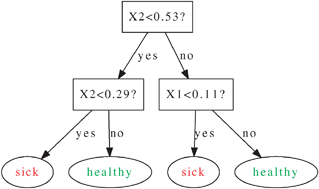At the intersection between artificial intelligence and statistics, supervised learning allows algorithms to automatically build predictive models from just observations of a system. During the last twenty years, supervised learning has been a tool of choice to analyze the always increasing and complexifying data generated in the context of molecular biology, with successful applications in genome annotation, function prediction, or biomarker discovery. Among supervised learning methods, decision tree-based methods stand out as non parametric methods that have the unique feature of combining interpretability, efficiency, and, when used in ensembles of trees, excellent accuracy. The goal of this paper is to provide an accessible and comprehensive introduction to this class of methods. The first part of the review is devoted to an intuitive but complete description of decision tree-based methods and a discussion of their strengths and limitations with respect to other supervised learning methods. The second part of the review provides a survey of their applications in the context of computational and systems biology.

You have access to this article
 Please wait while we load your content...
Something went wrong. Try again?
Please wait while we load your content...
Something went wrong. Try again?


 Please wait while we load your content...
Please wait while we load your content...